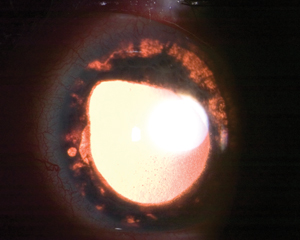 |
| Study reveals high incidence of uveitis in HZO patients, with diagnosis typically occurring in the second week and highlighting the role of early antiviral treatment in reducing vision loss. Photo: Aaron Bronner, OD. Click image to enlarge. |
A recent analysis found that uveitis developed in about half of individuals with herpes zoster ophthalmicus (HZO), with diagnosis occurring most often in the second week after the rash appeared. This research, published in the American Journal of Ophthalmology, also showed that eyes affected by uveitis were more likely to experience additional ocular complications and vision loss.
In this retrospective, cohort study, which included individuals with acute herpes zoster ophthalmicus, investigators sought to determine the timing of uveitis onset as well as the frequency of associated complications.
The primary outcomes measures included the proportion of individuals who developed uveitis and the time to uveitis diagnosis after HZO onset. Secondary outcome measures were the complications associated with HZO-related uveitis and the impact of early antiviral treatment (within 72 hours) on outcomes.
Of the 869 study participants, 413 (47.6%) developed uveitis. Data showed that the median time from onset of rash to uveitis diagnosis was 10 days. Among the 658 patients examined within the first week following rash appearance, 17.6% (116/658) were diagnosed at that initial presenting exam and an additional 24.9% (164/658) received a diagnosis at a subsequent visit.
Complications, including moderate or severe vision loss, corneal scarring, neurotrophic keratitis, band keratopathy, corneal melt, elevated intraocular pressure, glaucoma and cataract, were higher in eyes with uveitis. Prompt antiviral treatment was correlated with a lower rate of moderate vision loss among patients with the condition, according to the researchers.
“In summary, uveitis is a common complication of herpes zoster ophthalmicus and is associated with other ocular complications. Prompt antiviral did not appear to prevent onset of uveitis in this cohort but was associated with a lower risk of vision loss in those that did develop uveitis. The diagnosis of uveitis was most frequently made during the second week following the rash onset,” the study authors noted in their recent American Journal of Ophthalmology paper.
“Individuals examined during the first week after onset of HZO rash may still develop uveitis after that visit, and a follow up examination within the first month should be considered or they should be warned of the symptoms of uveitis that would prompt a repeat examination,” they concluded.
| Click here for journal source. |
Meyer JJ, Liu K, Danesh-Meyer HV, et al. Herpes zoster ophthalmicus uveitis: onset and complications. Am J Ophthalmol. September 19, 2024 [Epub ahead of print]. |


